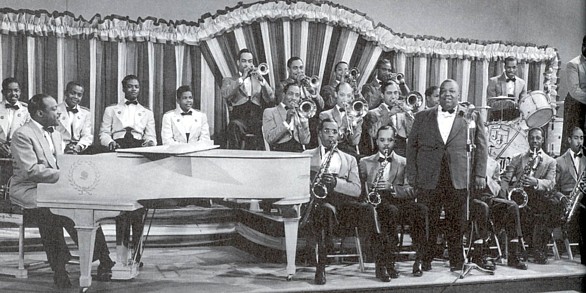
Already in the late 1920s, jazz bands get bigger (10 musicians) and the arrangements are beginning to emerge, especially in Fletcher Henderson, Louis Russell and Duke Ellington.
In Kansas City at the beginning of 1930s, Bennie Moten and some others create big orchestras called Big Band. Moten dies suddenly and Count Basie takes back his orchestra to create his famous bigband which will equal that of Duke Ellington, in the length and popularity.

Soon, bands from 15 to 20 musicians cover clubs and ballrooms American (4 trumpets, 4 trombones, 5 saxophones, rhythm section and singer). The style is out of New Orleans. This is the Swing, nonchalant, inherited from the boogie-woogie. It's always a dance music. Bass mark all time as the drums that also relies on the beat after (hi-hat cymbals play the 2nd and 4th time). The drummers are an important component of bigband : Sonny Greer, Jo Jones, Chick Webb, Gene Krupa, Buddy Rich ...
Jazz, which has grown rapidly thanks to the disc, radio, the prohibition and Jewish, Italian, irish mafias, becomes the most popular music.

In the 1940s, the Be Bop appears. Dizzy Gillespie mount bigband. In 1948, the Metronome All Stars, ephemeral bigband bebop, is full of stars of jazz.
Count Basie's bigband crosses decades with brio.
From the 1950s, it becomes difficult to mount a bigband. Two successes, however: Thad Jones & Mel Lewis, Gil Evans.
Thad Jones, a former trumpeter with Basie and brilliant arranger, joins the drummer Mel Lewis.
Gil Evans, pianist, arranger, conductor, worked with Miles Davis in 4 albums including "Porgy and Bess" and "Sketches of Spain".
The Big Band Era at BJazz







